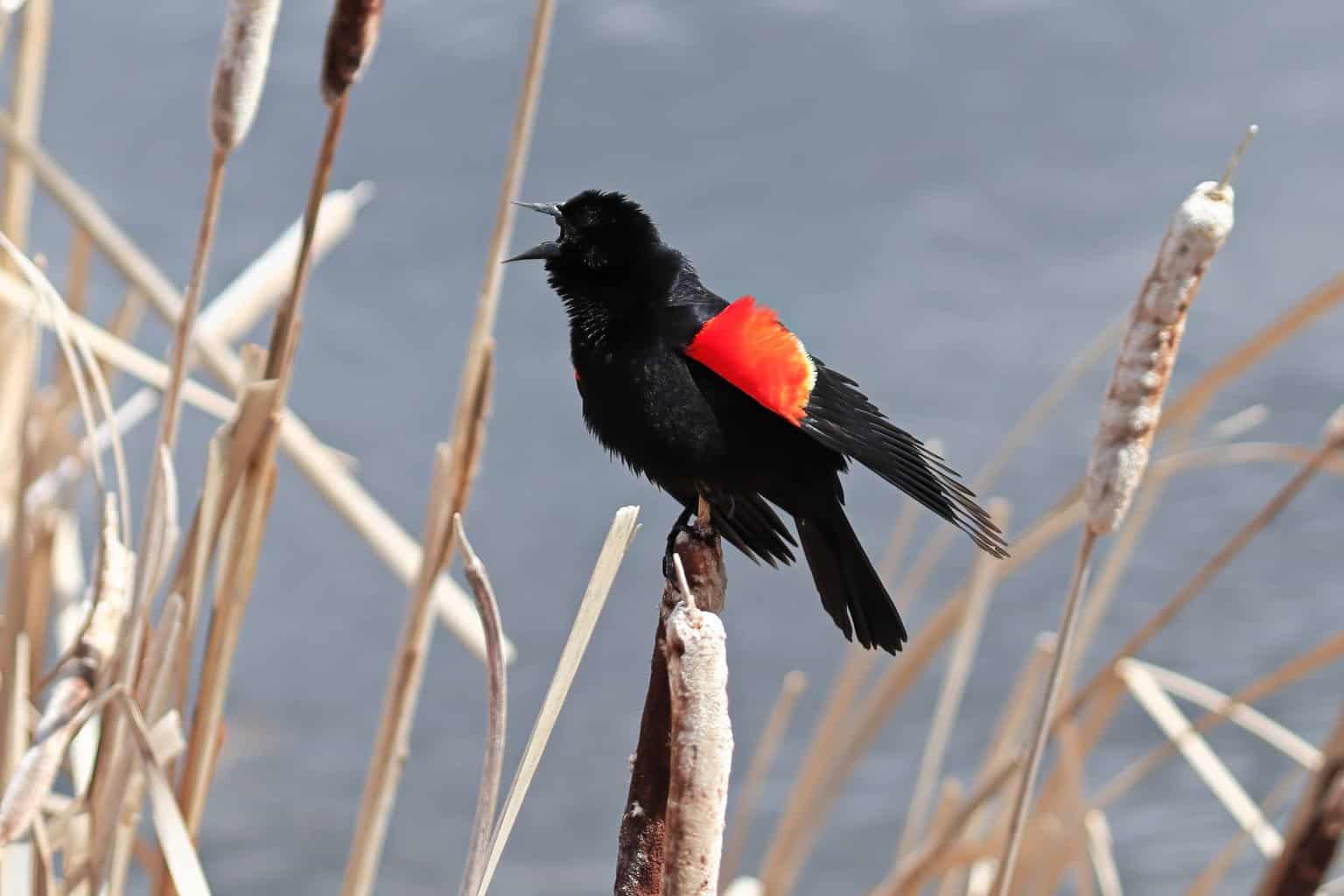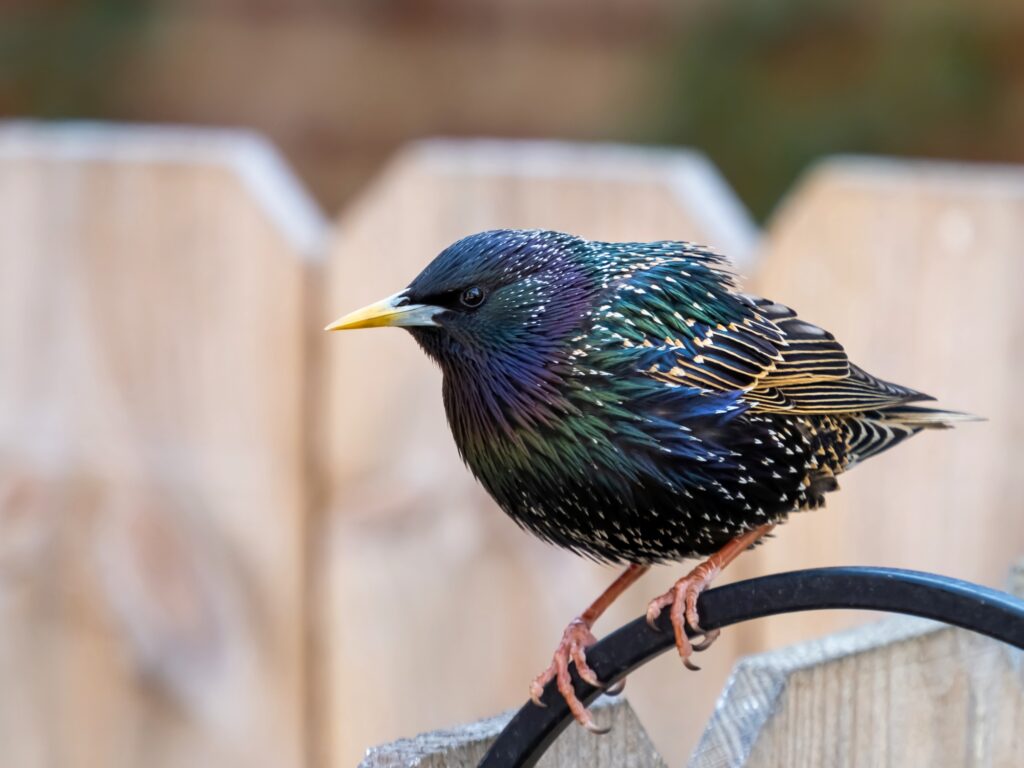Blackbirds in New Hampshire are often considered pests. But these birds can be more interesting than you might think.
Most blackbirds in New Hampshire are those birds within the Icteridae family which are referred to as new world blackbirds. As you will discover, blackbirds are varied birds—and often, are not even black.
Learning how to identify the different blackbirds you might see (both the new world blackbirds and one non-native European species) can help you to feel more connected to the natural world.
It can also mean that you might be able to help in conservation since numbers of some species have dropped dramatically in recent years and some species in this area are near-threatened.
So here are some details to help you understand when you might see different blackbirds in New Hampshire, and how to identify them when you do.
Red-Winged Blackbird

- Scientific Name: Agelaius phoeniceus
- Length: 6.7 – 9.1 in (17 – 23 cm)
- Weight: 1.1 – 2.7 oz (32 – 77 g)
- Wingspan: 12.2 – 15.8 in (31 – 40 cm)
The blackbirds that you are most likely to see in New Hampshire during the summer are red-winged blackbirds. Red-winged blackbirds usually arrive in spring and depart in fall, but a few will remain in the state and so can also occasionally be seen here in the winter.
Red-winged blackbird males are easily identified by their black plumage and red wing patches. The female blackbirds are a less striking streaky brown.
Common Grackle

- Scientific Name: Quiscalus quiscula
- Length: 11.0 – 13.4 in (28 – 34 cm)
- Weight: 2.6 – 5.0 oz (74 – 142 g)
- Wingspan: 14.2 – 18.1 in (36 – 46 cm)
Common grackles are the second most commonly spotted blackbirds in New Hampshire during the summer months. They typically arrive in spring and spend the summer in the state before migrating back south in the fall.
However, some remain here all year round and so there are also some sightings in the winter months.
Their glossy black bodies are slightly taller than other blackbirds and have longer tails. The females have a little less iridescence than the males.
European Starling

- Scientific Name: Sturnus vulgaris
- Length: 7.9 – 9.1 in (20 – 23 cm)
- Weight: 2.1 – 3.4 oz (60 – 96 g)
- Wingspan: 12.2 – 15.8 in (31 – 40 cm)
The only non-native bird on this list, the European starling is an introduced species now commonly sighted here and across much of the US. They do not migrate and will remain and be seen in New Hampshire year-round.
Sometimes gathering in large flocks and creating huge murmurations in the sky, these birds are stunning en mass.
Up close, they are also more striking than they at first appear, with glossy sheens of green, blue, and purple in their plumage.
Brown-Headed Cowbird

- Scientific Name: Molothrus ater
- Length: 76.3 – 8.7 in (19 – 22 cm)
- Weight: 1.3 – 1.8 oz (42 – 50 g)
- Wingspan: 14.2 in (36 cm)
You are most likely to spot brown-headed cowbirds in New Hampshire between March and August. Most members of brown-headed cowbirds will migrate—heading south to warmer climes for the winter months. But some brown-headed cowbirds will remain here in the winter.
The males give the species its name, with their black bodies and brown heads. The female cowbirds are smaller and they are a streaky grayish-brown color all over.
Baltimore Oriole

- Scientific Name: Icterus galbula
- Length: 6.7 – 7.5 in (17 – 19 cm)
- Weight: 1.1 – 1.4 oz (30 – 40 g)
- Wingspan: 9.1 – 11.8 in (23 – 30 cm)
These are the third most prevalent blackbird in New Hampshire over the summer months. They spend the breeding season in the state, residing here between May and around September.
In fall, most will head south for their wintering grounds, but some will remain so these birds can also occasionally be spotted here during the winter months.
Around the same size as a robin, the females are yellow underneath, gray-brown on their wings, and yellow-brown on their backs. Adult males are bright orange and black, with white wing bars.
Bobolink

- Scientific Name: Dolichonyx oryzivorus
- Length: 5.9 – 8.3 in (15 – 21 cm)
- Weight: 1.0 – 2.0 oz (29 – 56 g)
- Wingspan: 10.6 in (27 cm)
Bobolinks can be seen in New Hampshire during the breeding season. They tend to arrive around May for breeding season and depart to migrate back south in the fall. They will usually have left the state by the end of October.
Breeding males are an unusual and rather amusing sight. They have a small yellow patch on their heads that looks like hair. This stands out alongside their white wing bars and backs, and black bellies.
Non-breeding males and females are plainer, with streaky brown coloration and darker marks around their eyes and stripes on their crowns.
Rusty Blackbird

- Scientific Name: Euphagus carolinus
- Length: 8.3 – 9.8 in (21 – 25 cm)
- Weight: 1.7 – 2.8 oz (47 – 80 g)
- Wingspan: 14.6 in (37 cm)
The rusty blackbird is considered to be a vulnerable species in New Hampshire. They can potentially be spotted here all year round. But they are most commonly seen here during the spring migration in April or the fall migration in October.
In summer, the males have their glossy black breeding plumage. In other seasons, they take on a more rusty reddish-brown coloration.
The females have rusty coloration along feather edges too and are a grayish-brown overall.
Orchard Oriole

- Scientific Name: Icterus spurius
- Length: 5.9 – 7.1 in (15 – 18 cm)
- Weight: 0.6 – 1.0 oz (16 – 28 g)
- Wingspan: 9.8 in (25 cm)
Orchard orioles are not very commonly sighted in New Hampshire, but they are known to occur regularly here.
They breed in the state, most commonly arriving in around May and departing around September to migrate south.
The males have bold coloring. They have reddish bellies and black backs and heads. The females do not look like them at all.
They are a green-yellow color, a little paler underneath and darker above, with darker wings with white wing bars.
Eastern Meadowlark

- Scientific Name: Sturnella magna
- Length: 7.5 – 10.2 in (19 – 26 cm)
- Weight: 3.2 – 5.3 oz (90 – 150 g)
- Wingspan: 13.8 – 15.8 in (35 – 40 cm)
A near-threatened species, eastern meadowlarks are still seen in New Hampshire during the summer breeding season. You will stand the best chance of a glimpse of this elusive species between March and July.
These medium-sized songbirds have yellow bellies marked with a bold black band, and backs that are pale brown with black marks.
Even if you do not see them, you may, if you are lucky, hear their fluting musical songs. This species can sing more than 100 different songs.
Yellow-Headed Blackbird

- Scientific Name: Xanthocephalus xanthocephalus
- Length: 8.3 – 10.2 in (21 – 26 cm)
- Weight: 1.6 – 3.5 oz (44 – 100 g)
- Wingspan: 16.5 – 17.3 in (42 – 44 cm)
Yellow-headed blackbirds are very rarely spotted here, but they are deemed to be regularly occurring in New Hampshire.
The males have glossy black bodies, vivid yellow heads and chests, and white wing bars. The females are brown and the yellow hue on them is duller than it is on the males.
The blackbirds are a little larger than the red-winged blackbird.
Final Thoughts
These are the main species to look out for. There have also been rare sightings of Bullock Orioles (spotted in Dover in 2021) and Western meadowlarks (seen in Rockingham in 2017, for example).
However, the species on this list are the main blackbirds for birdwatchers in New Hampshire!

